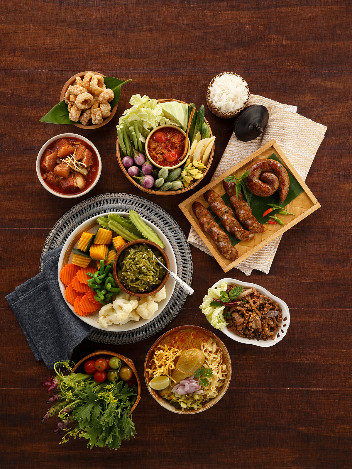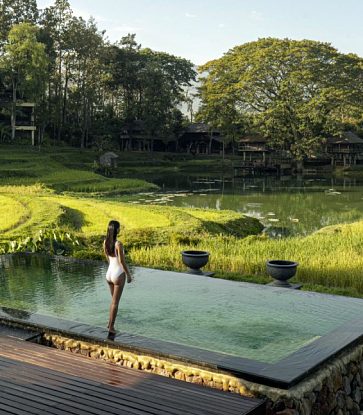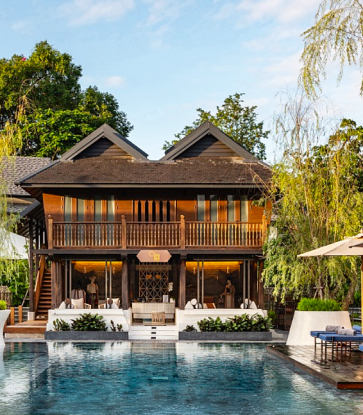Presenting an assortment of individually prepared dishes at once is common in many cultures. China has Dim Sum, Korea has Banchan, India has Thali, and when it comes to northern Thailand, things get celebratory with Khan Tok.
Khan Tok is both the name of the serving tray as well as the meal itself. As most Thais traditionally ate whilst seated on the floor, the Khan Tok was a tray with a pedestal base to elevate the dishes above floor level. This style of tray can be found in northern as well as northeastern Thai (Isaan). The Khan Tok trays of Chiang Mai can be made of various materials, from humble wicker to exquisite gold gilded wood, but they are all used for the same purpose - to elegantly display an assortment of smaller dishes that complement one another.

Unlike most other regions of Thailand where locals typically prefer steamed jasmine rice, the northern parts of the country favour glutinous or “sticky” rice with their meals. This plays an important role in how Khan Tok is plated, as many of the accompanying dishes and relishes are particularly suited for dipping into and spread over glutinous rice. Aside from rice, here are some of the key items found in Khan Tok.

Curries
Northern curries are usually a bit thicker and less spicy than their southern Thai counterparts. They also rarely use coconut milk. You’ll be given at least one curry to try in a Khan Tok. Common dishes include Gaeng Haeng Lae (Burmese-style Pork Belly Curry), Gaeng Om (Lemongrass Curry that can be paired with various meats), and Gaeng No Mai (Bamboo Curry).
Relishes
It’s hard to imagine Khan Tok without a relish. You’ll likely see the ubiquitous Nam Phrik Num (Banana Pepper Relish) or Nam Phrik Ong (Tomato and Ground Pork Relish), if not both. These relishes will be paired with steamed and fresh vegetables like cucumber, cabbage and pumpkin as well as Khap Mu (Deep Fried Pork Rind). Due to the abundance of jungle areas in the north, you may also find foraged herbs and vegetables like young banana flowers or young leaves from the mango or tamarind trees that add a unique sour taste to the meal.
Meats
Pork, chicken, beef and freshwater fish can all be used as the main protein in Khan Tok. These meats are presented in smaller, easy to divide pieces, and usually deep-fried, stir-fried, grilled or turned into a Larb (minced meat salad with herbs). Sai Oua (Northern Thai Sausage) is another common dish.

Of course, due to the nature of having several different plates, there are many variations of Khan Tok throughout northern Thailand. Some local specials may include stir-fried vegetables or dessert items. The excitement is in the variety offered, and the ability to mix and match a meal to your tastes.
Enjoying Khan Tok can be a wonderful introduction to northern cuisine, as it allows you to try a variety of things at once. Khan Tok is best eaten in the traditional manner while sitting on the floor. Use your fingers to create portions of sticky rice, then scoop some bits of each dish onto your own plate. Again, use your hands to dip and taste the sticky rice with each side dish.
Ready to try it out for yourself? Here are our recommendations for Khan Tok dining in Chiang Mai.
Please note that these restaurants are recommended by our writer only, not the MICHELIN Guide Inspectors.
Banpihuennong Halal Khantoke
Although slightly farther away from Chiang Mai city, this quaint restaurant with a vintage vibe is definitely worth a visit for a full halal Khan Tok.
349/1 Mu 5, Yang Noeng, Saraphi
Tel. +66 53 963 438
Facebook: Banpihuennong Halal Khantoke
Khan Tok of the Old Chiangmai Cultural Centre
Conveniently located in the city, this spot was where the Khan Tok dinner show first originated in the 1970s, pairing northern Thai dining with northern Thai traditional dance. Be sure to make a booking and arrive before 18:45 p.m. for the dinner show.
185/3 Wualai Road, Haiya, Mueang, Chiang Mai
Tel. +66 0 53 202-993-5
Email: info@oldchiangmai.com
Website: http://www.oldchiangmai.com
Khum Khantoke, Chiang Mai
Along with a classical dance performance, Khum Kantoke also provides vegetarian and halal versions of the traditional Khan Tok dinners.
139 Mu 4, Nong Pa Khrang, Mueang, Chiang Mai
Tel. +66 53 244 141
Email: booking@khumkhantoke.com
Website: http://www.khumkhantoke.com
More information:
TOURISM AUTHORITY OF THAILAND, CHIANG MAI OFFICE
105/1 Chiang Mai-Lamphun Road, Tambon Watgate, Amphoe Mueang, Chiang Mai
Tel. +66 (0) 5324 8604-5
Email : tatchmai@tat.or.th
www.tourismthailand.org/chiangmai
This article is brought to you by the Tourism Authority of Thailand.
To know more about the Tourism Authority of Thailand, please visit https://www.tourismthailand.org/





















